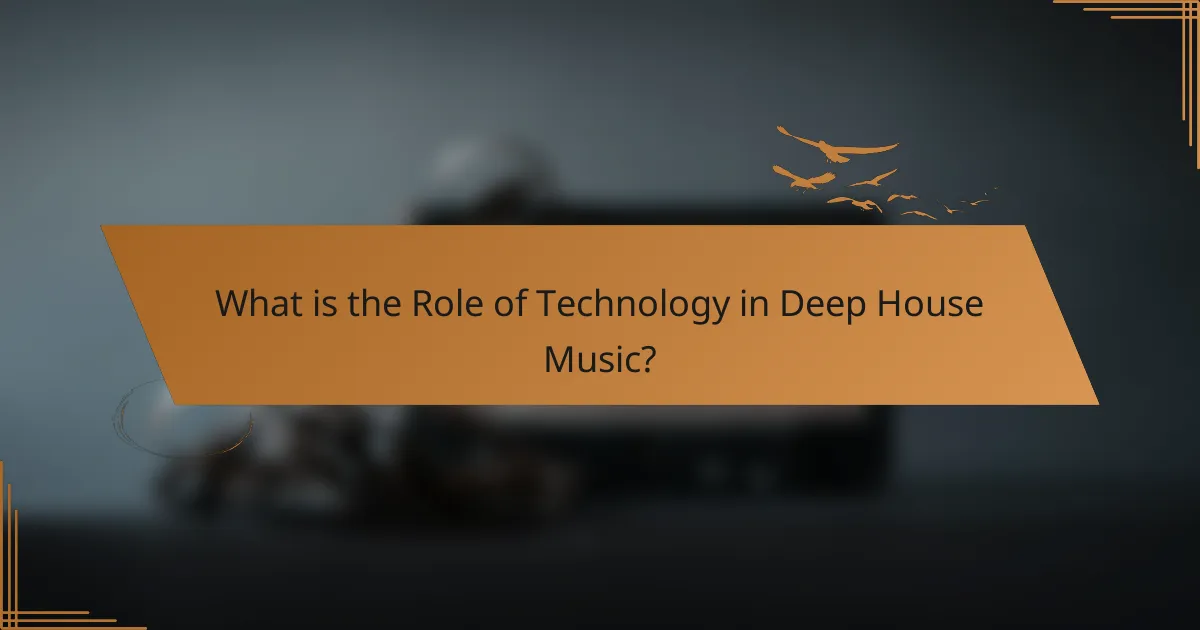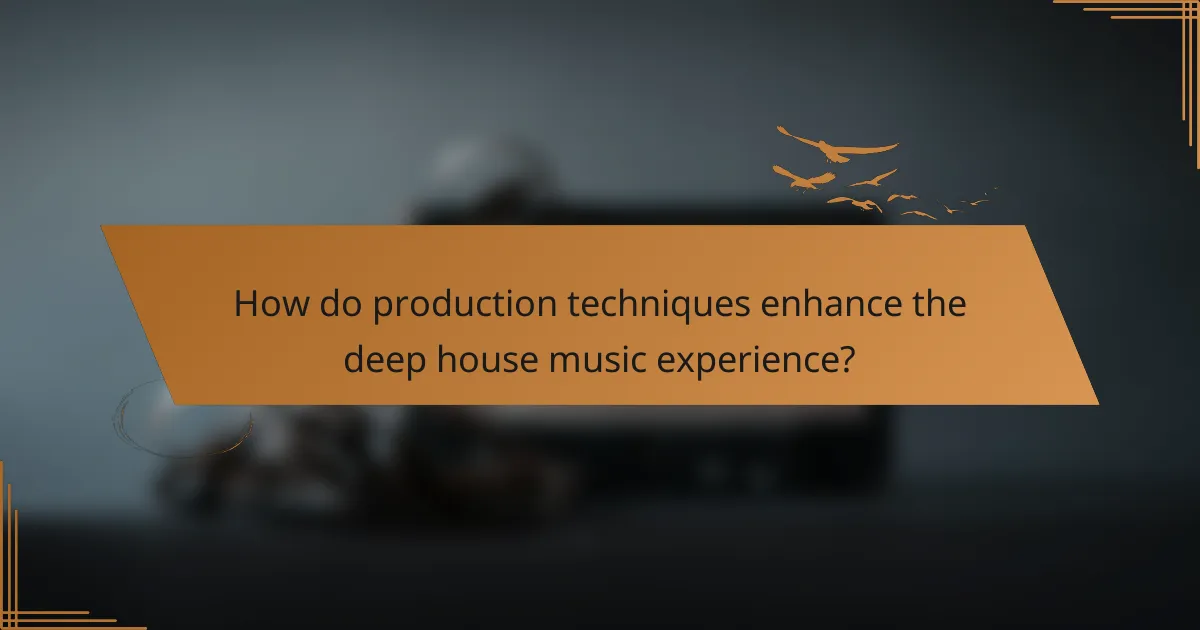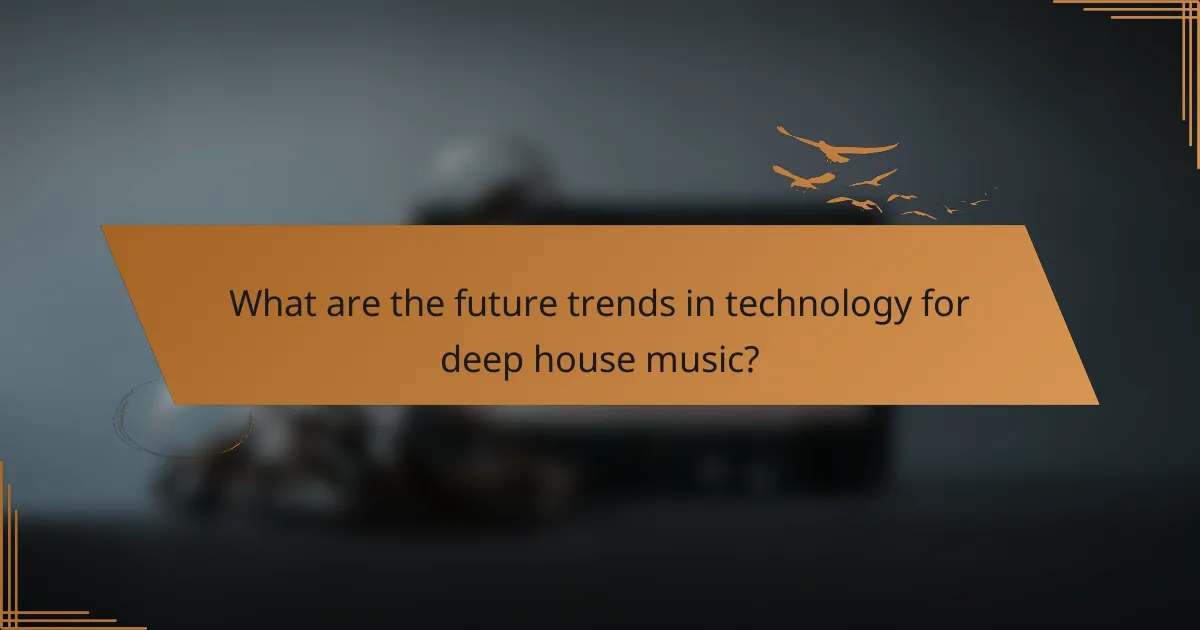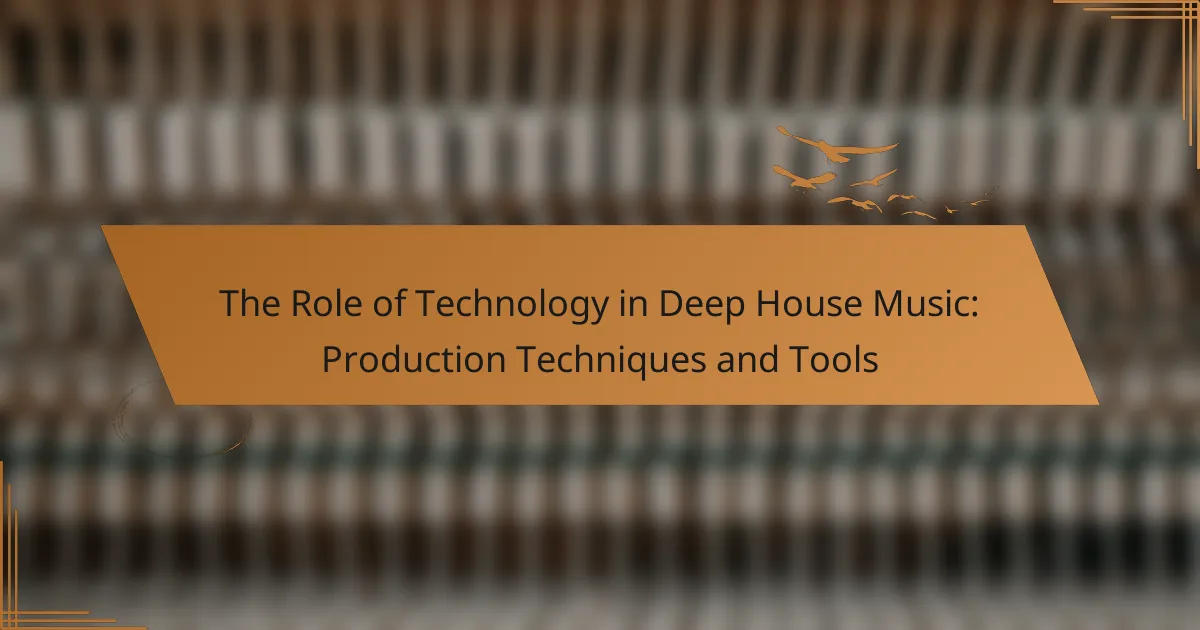Technology significantly influences deep house music production, allowing artists to create and enhance sounds using various tools. Digital Audio Workstations (DAWs), software synthesizers, MIDI controllers, and sampling technology are essential for composing intricate tracks and enriching the auditory experience. Production techniques such as layering, sampling, and the application of effects contribute to the depth and texture of the music. Future trends indicate a shift towards AI-driven tools, virtual reality enhancements for live performances, and blockchain technology for transparent distribution, promising a more collaborative and immersive music creation landscape.

What is the Role of Technology in Deep House Music?
Technology plays a crucial role in deep house music production. It enables artists to create, manipulate, and enhance sounds. Digital Audio Workstations (DAWs) are essential tools for composing and arranging tracks. Software synthesizers provide a wide range of sounds and textures. MIDI controllers allow for expressive performance and control over virtual instruments. Sampling technology lets producers incorporate diverse audio elements into their tracks. Effects processors enhance sound quality and add depth. Furthermore, technology facilitates distribution through streaming platforms. This accessibility has expanded the audience for deep house music globally.
How has technology influenced the evolution of deep house music?
Technology has significantly influenced the evolution of deep house music. The introduction of digital audio workstations (DAWs) revolutionized music production. Artists can now compose, edit, and arrange tracks with unprecedented ease. Synthesizers and drum machines have expanded the sound palette available to producers. This allows for innovative textures and rhythms that define deep house. The rise of online distribution platforms has changed how music is shared and consumed. Artists can reach global audiences without traditional record labels. Additionally, advancements in sound processing technology have improved audio quality. These developments have collectively shaped the contemporary deep house sound.
What historical advancements in technology have shaped deep house music?
The historical advancements in technology that have shaped deep house music include the development of synthesizers, drum machines, and digital audio workstations (DAWs). Synthesizers like the Roland Juno-106 and Moog Minimoog allowed artists to create unique sounds. Drum machines such as the Roland TR-808 became iconic for their punchy bass and snare sounds. The introduction of DAWs in the late 1990s revolutionized music production, enabling easier editing and arrangement. MIDI technology facilitated communication between devices, streamlining the production process. These innovations collectively influenced the sound and structure of deep house music, allowing for greater creativity and experimentation.
How do modern technologies redefine the sound of deep house music?
Modern technologies redefine the sound of deep house music by introducing advanced production tools and techniques. Digital audio workstations (DAWs) enable precise editing and manipulation of sounds. Synthesizers and samplers create unique textures and layers that enhance the genre’s depth. MIDI controllers facilitate more expressive performances and real-time adjustments. Software plugins provide a wide range of effects, such as reverb and compression, to shape the sound. Additionally, online collaboration tools allow artists to work together across distances, blending diverse influences. These innovations lead to a more polished and varied sound in deep house music.
What are the key production techniques in deep house music?
Key production techniques in deep house music include the use of sampling, layering, and effects processing. Sampling involves incorporating snippets from other tracks or sounds to create a unique composition. Layering is the technique of stacking multiple sounds or instruments to add depth and richness to the music. Effects processing, such as reverb and delay, enhances the overall sound and creates an immersive listening experience. Additionally, sidechain compression is commonly used to create a pumping effect, allowing the kick drum to stand out. These techniques are essential for achieving the characteristic sound of deep house music.
How do producers utilize digital audio workstations (DAWs) in deep house music?
Producers utilize digital audio workstations (DAWs) in deep house music for composing, arranging, and mixing tracks. DAWs provide a platform for creating complex sounds and layering multiple audio tracks. They enable producers to manipulate audio samples and synthesize new sounds. Producers use MIDI sequencing to program beats and melodies. DAWs also facilitate the use of virtual instruments and effects plugins. This enhances the creative possibilities within deep house music. Additionally, DAWs allow for precise editing and automation of sound parameters. The flexibility and efficiency of DAWs streamline the production process, making them essential tools in deep house music creation.
What role do synthesizers play in creating deep house tracks?
Synthesizers are essential in creating deep house tracks. They generate a wide range of sounds and textures. Deep house music relies on rich, atmospheric elements. Synthesizers contribute lush pads and deep basslines. They enable producers to craft unique melodies and harmonies. Various synthesis methods, like subtractive and FM synthesis, shape the sound. The use of filters and modulation adds movement and depth. Synthesizers also allow for experimentation with sound design. This versatility is crucial for defining the deep house genre.
What tools are essential for producing deep house music?
Essential tools for producing deep house music include a digital audio workstation (DAW), synthesizers, and audio interfaces. A DAW, like Ableton Live or FL Studio, is crucial for arranging and editing music tracks. Synthesizers, such as Serum or Massive, provide unique sounds and textures typical in deep house. Audio interfaces, like Focusrite Scarlett, improve sound quality and connectivity. Additionally, MIDI controllers facilitate live performance and production. These tools are foundational for achieving the characteristic sound of deep house music.
Which software plugins are popular among deep house producers?
Popular software plugins among deep house producers include Serum, Massive, and Sylenth1. Serum is known for its wavetable synthesis and versatility. Massive offers deep bass and rich leads, making it a staple. Sylenth1 is favored for its warm sound and user-friendly interface. Other notable plugins are Omnisphere for its extensive sound library and FabFilter Pro-Q for precise EQing. These plugins enhance sound design and production quality in deep house music. Their popularity is backed by their widespread use in professional tracks and tutorials.
How do hardware instruments contribute to deep house music production?
Hardware instruments enhance deep house music production by providing unique sound textures and hands-on control. They include synthesizers, drum machines, and samplers. These devices allow producers to create rich, layered sounds that define the genre. For example, analog synthesizers produce warm, organic tones that digital instruments often cannot replicate. Drum machines contribute distinctive rhythmic patterns crucial for deep house grooves.
Additionally, hardware instruments facilitate a tactile music-making experience. This physical interaction can inspire creativity and spontaneity in the production process. Many deep house producers prefer hardware for its ability to generate unique sonic characteristics. The use of hardware can also lead to a more dynamic and engaging live performance.
Research indicates that hardware instruments can improve the overall sound quality of music productions. A study by the University of California found that analog equipment often adds desirable harmonic distortion. This characteristic is often sought after in deep house music to create depth and warmth.

How do production techniques enhance the deep house music experience?
Production techniques enhance the deep house music experience by creating immersive soundscapes and intricate rhythms. Techniques such as layering, sampling, and the use of effects contribute to depth and texture. Layering allows multiple sounds to blend, enriching the overall auditory experience. Sampling incorporates diverse elements, adding unique character to tracks. Effects like reverb and delay create spatial awareness, making the music feel more expansive. Additionally, dynamic mixing ensures that all elements are balanced, enhancing listener engagement. The use of synthesizers adds warmth and complexity, characteristic of deep house. These production choices collectively elevate the emotional and sensory impact of the music.
What specific techniques are used to create unique sounds in deep house music?
Deep house music utilizes several specific techniques to create unique sounds. One key technique is the use of sampling, where snippets of audio from various sources are incorporated into tracks. This can include vocal samples or instrumental loops that add texture. Another technique is layering, which involves combining multiple sound elements to create a fuller sound. Producers often use synthesizers to craft rich, deep basslines and atmospheric pads.
Additionally, effects processing is crucial. Techniques such as reverb, delay, and filtering shape sounds and add depth. Sidechain compression is frequently employed to create a pumping effect, enhancing the groove. Lastly, automation allows producers to dynamically change parameters over time, contributing to the evolving soundscape typical of deep house tracks. These techniques collectively contribute to the genre’s distinctive auditory experience.
How does layering affect the depth of deep house tracks?
Layering enhances the depth of deep house tracks by adding richness and complexity to the sound. It involves combining multiple audio elements, such as synths, vocals, and percussion. Each layer contributes unique textures and frequencies. This creates a fuller sonic experience for listeners. The interplay between layers can evoke emotional responses. Effective layering can also improve the spatial quality of a track. For instance, using stereo imaging techniques widens the sound field. This results in a more immersive listening experience. Studies show that well-layered tracks are more engaging and memorable.
What is the importance of mixing and mastering in deep house music?
Mixing and mastering are crucial processes in deep house music production. They enhance the overall sound quality and ensure clarity in the mix. Mixing balances individual tracks, adjusting levels, panning, and applying effects. This process creates a cohesive sound that maintains the genre’s rhythmic and melodic elements. Mastering prepares the final mix for distribution. It optimizes the track’s loudness and tonal balance for various playback systems. Proper mastering ensures the music sounds consistent across different platforms. According to a study by the Audio Engineering Society, well-mixed and mastered tracks significantly improve listener engagement and satisfaction. Therefore, these processes are essential for achieving a professional sound in deep house music.
How do technology and creativity intersect in deep house music production?
Technology and creativity intersect in deep house music production through the use of digital audio workstations (DAWs) and innovative sound design techniques. DAWs enable producers to manipulate audio with precision. They provide tools for recording, editing, and mixing music seamlessly. Creative sound design involves synthesizers and sampling techniques that shape unique sounds. Producers often use MIDI controllers to enhance their creative expression. Technology allows for real-time manipulation of sound, fostering improvisation. The integration of plugins expands the sonic palette available to artists. This blend of technology and creativity results in diverse and evolving deep house music.
What innovative approaches are producers taking with technology?
Producers in deep house music are utilizing advanced software and hardware to enhance creativity and efficiency. They are increasingly adopting digital audio workstations (DAWs) like Ableton Live and FL Studio for their flexibility and extensive libraries. Many producers are integrating MIDI controllers to streamline their workflow and improve live performance capabilities. Additionally, the use of virtual instruments and plugins allows for unique sound design and experimentation. Cloud-based collaboration tools are also gaining popularity, enabling remote teamwork and sharing of projects. Innovations in sampling technology are allowing producers to manipulate sounds in unprecedented ways. Furthermore, artificial intelligence is being explored for generating music and assisting in mixing processes. These approaches reflect a significant shift toward technology-driven production in the deep house genre.
How does technology enable collaboration among deep house artists?
Technology enables collaboration among deep house artists through digital audio workstations (DAWs) and cloud-based platforms. DAWs allow multiple artists to create and edit music remotely. Artists can share projects in real-time using platforms like Splice or Soundtrap. These tools facilitate the exchange of samples, loops, and ideas seamlessly. Additionally, online collaboration tools enable artists to communicate effectively, regardless of location. The use of video conferencing software enhances real-time discussions and feedback. This technological integration accelerates the creative process and expands artistic possibilities. Statistics show that over 70% of musicians collaborate online, highlighting the trend’s significance in modern music production.

What are the future trends in technology for deep house music?
Future trends in technology for deep house music include advanced AI-driven music production tools. These tools will assist artists in creating unique sounds and automating repetitive tasks. Additionally, virtual reality (VR) will enhance live performances, immersing audiences in interactive environments. Blockchain technology may also play a role in music distribution, ensuring transparency and fair compensation for artists. Furthermore, the integration of machine learning will enable personalized music recommendations for listeners. Enhanced software plugins will continue to evolve, offering innovative sound manipulation options. These trends indicate a shift towards more collaborative and engaging music creation experiences.
How is artificial intelligence shaping the production of deep house music?
Artificial intelligence is transforming the production of deep house music by automating various creative processes. AI algorithms can analyze existing tracks to generate new compositions that adhere to genre-specific characteristics. These systems can assist producers in sound design by suggesting samples and effects that fit the desired aesthetic. Machine learning models can also predict listener preferences, helping artists tailor their music to audience trends. AI-driven tools facilitate real-time collaboration between musicians, enhancing workflow efficiency. Furthermore, AI can optimize mixing and mastering processes, ensuring high-quality sound output. Studies indicate that AI-generated music has gained popularity, indicating its acceptance in the industry.
What emerging technologies are likely to influence deep house music in the coming years?
Artificial intelligence and machine learning are emerging technologies likely to influence deep house music. These technologies enable music producers to analyze trends and create unique sounds. AI-driven software can assist in composing, mixing, and mastering tracks. Additionally, virtual reality (VR) and augmented reality (AR) are set to enhance live performances. These technologies allow for immersive experiences that engage audiences in new ways. Blockchain technology may also impact music distribution and rights management. This ensures artists receive fair compensation for their work. Overall, these technologies are reshaping how deep house music is produced and experienced.
What best practices can aspiring producers follow in deep house music production?
Aspiring producers in deep house music should focus on sound selection and layering. Choosing high-quality samples is crucial for creating rich textures. Layering different sounds can enhance depth and complexity. Producers should also pay attention to groove and rhythm. Using swing and shuffle can create a more organic feel.
Additionally, mastering EQ and compression techniques is essential. Proper EQ helps to carve out space for each element in the mix. Compression controls dynamics and adds punch to the sound. Experimenting with effects like reverb and delay can add atmosphere.
Producers should also consider arrangement and structure. A well-structured track keeps listeners engaged. Finally, seeking feedback from peers can provide valuable insights. Constructive criticism helps refine production skills.
How can producers effectively use technology to enhance their creativity?
Producers can effectively use technology to enhance their creativity by leveraging digital audio workstations (DAWs) and various software tools. DAWs like Ableton Live and FL Studio provide an intuitive interface for music creation. These platforms allow for easy manipulation of sound and arrangement. Producers can utilize virtual instruments and plugins to expand their sonic palette. Tools like Serum and Massive offer unique sound design capabilities. Additionally, technology enables collaboration through cloud-based platforms. This fosters creativity by allowing real-time feedback and idea sharing. Data from a 2020 survey by Sound on Sound indicated that 85% of producers reported increased creativity through technology use. Thus, technology serves as a catalyst for innovative music production in deep house.
What common pitfalls should producers avoid when using technology in deep house music?
Producers should avoid over-reliance on technology in deep house music. This can lead to a lack of originality in sound. Excessive use of presets can result in music that sounds generic. Relying too heavily on software plugins may diminish creativity. Additionally, neglecting the importance of sound design can produce uninspired tracks. Failing to balance digital and analog elements may cause a loss of warmth in the music. Ignoring the importance of proper mixing and mastering can lead to poor sound quality. Lastly, overlooking the value of live instrumentation can limit the depth and authenticity of a track.
The main entity of the article is technology in deep house music. The article explores the pivotal role technology plays in the production of deep house music, detailing essential tools such as digital audio workstations (DAWs), synthesizers, and sampling techniques. It examines how advancements in technology have influenced the genre’s evolution, highlighting key production techniques that enhance sound depth and quality. Additionally, the article discusses the intersection of technology and creativity, the importance of mixing and mastering, and future trends that may shape the landscape of deep house music.
